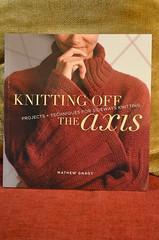First, the facts:
Title: Knitting Off the Axis: Projects & Techniques for Sideways Knitting
Author: Mathew Gnagy
Published by: Interweave Press, 2011
Pages: Text
Type: Sweaters. 15 really unique sweater patterns.
Chapters:
1. Truly Sideways
2. Mostly Sideways
3. Every Which Way
Pattern Size Range: Text
The In-Depth Look:
“In earlier days, sideways knitting was usually confined to a dolman-style garment or a shapeless T. I have never subscribed to such one-dimensional thinking. Instead, I like to create nicely shaped underarms that fit will against he body. I like to knit sideways because there are interesting variations on shapes that are easier to create with sideways knitting.”
“My inspiration for the form and shape of my sweaters most often comes from the fashion metropolis of New York City. Frequently, as I walk about during my daily routine, I notice people wearing unique and unusual clothing. Tailored coats always intrigue me. Their stunning silhouettes help me discover compelling shapes that lend themselves beautifully to sideways construction.”
With a start like that, it shouldn’t surprise you that the designs in this book are unique. The designer is literally looking at the concept of knitting a sweater from a completely new angle.
Of course, when I say “unique,” I’m talking about the construction–not using it as a euphemism for “weird.” (What? Would I do that?) These sweaters are full of creative design elements, but they are beautiful, wearable sweaters, not the kind of wearable art you see on high fashion runways.
Hmm … this all sounds kind of backwards-compliment, but that’s not my point at all. I LIKE sweaters that look like something I could wear to work or out with friends. And I LOVE sweaters that are fun to knit, whether because of luscious yarn, interesting stitches or unusual construction … and these designs definitely fall under that last category. They’re full of surprising elements like shaping hidden in short rows, or using cables for stability, but the final results are often deceptively simple.
In other words, the designs look like a hell of a lot of fun to knit.
The breakdown? Fifteen designs, of which three are sweaters for men (each of which I adore, incidentally), one is a cape, and the other eleven are sweaters for women–and all of them are beautiful and interesting. All of them are made from a single color yarn–no colorwork–and most of them have a lot of textural elements. There are thorough schematics for each (vital for sweaters made with unusual construction techniques). There’s also a complete table of contents and index, too, which makes my cross-referencing heart happy.
There are also plenty of pictures for each design–though it throws me off, that the full-size picture that shows the whole design comes at the very end of the pattern, with only “pieces” at the front. That means, flipping through the book, first you see the collar, then a cuff, a shoulder … but no idea that it’s a waist-length bolero, a dolman-sleeved pullover, or a jacket-inspired knit until the end. It seems like an unusual choice of layout, but I suppose it’s much like the patterns themselves–you address each little detail and then, voila! You have a complete sweater.
The author stresses right up front that some things–like your row gauge–are more important to sideways knitting than they are to vertical knitting, and gives some admonishments about how to properly assemble your finished projects. He also has some very firm opinions about certain things, like how you measure your gauge (lay your work completely flat), or what you use to weave in your ends. (Hint: It’s not the tail end of your working yarn.)
If you want to check out this unique book, take a look at it here at Amazon.com.
Want to see bigger pictures? Click here.

This review copy was kindly donated by Interweave Press. Thank you!


